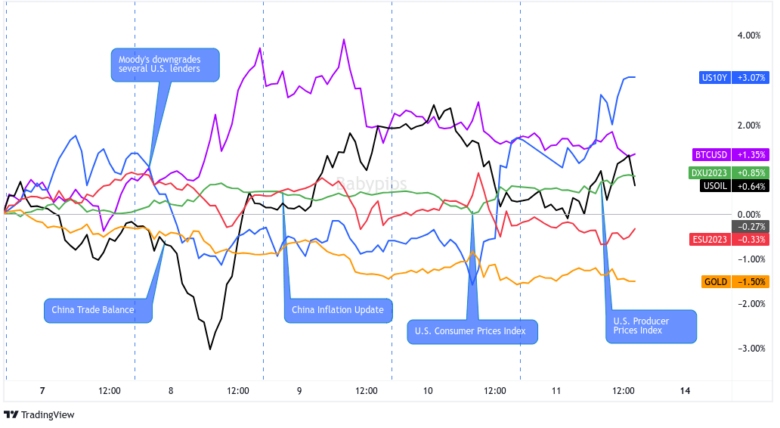The market spotlight shifted to U.S. inflation data this week, as traders were keen to find out if the latest CPI figures would further support the peak rate hike cycle narrative.
A couple of top-tier data points from China managed to steal the show around the middle of the week, though, and the lack of stimulus updates left investors on edge.
So, what exactly happened? I can explain, but lemme show you the biggest headlines first:
Notable News & Economic Updates:
? Broad Market Risk-on Arguments
Germany Final CPI for July: 6.2% (6.2% forecast; 6.4% previous); “the development of food prices continues to have an upward effect on inflation. In addition, the increase in energy prices was again somewhat larger than in the two previous months.”
Australia’s ANZ job advertisements picked up by 0.4% m/m in July vs. earlier 2.7% slump (downgraded from initially reported 2.5% drop)
NAB business confidence index improved from downgraded -1 figure in June to +2 in July, reflecting slightly better conditions
New Zealand quarterly inflation expectations ticked higher from 2.79% to 2.83% q/q, suggesting a potential pickup in price pressures over the next two years
ECB Economic Bulletin: Governing Council still sees inflation remaining too high for an extended period of time
RBA head Lowe: To get inflation to target in 2024 would require substantially higher rates
U.S. CPI for July: 3.2% y/y (3.3% y/y forecast; 3.0% y/y previous); Core CPI at 4.7% y/y (4.8% y/y forecast/previous); U.S. PPI for July: 0.3% m/m (0.2% m/m forecast; 0.0% m/m previous)
U.K. economy records surprise growth, up by 0.2% q/q in Q2 (vs. 0.1% in Q1, 0.0% expected), aided by growth across manufacturing, computer programming, and hospitality
? Broad Market Risk-off Arguments
Moody’s downgraded 10 mid-size regional U.S. banks and put six other lenders on notice under review
German industrial production slowed by 1.5% m/m in July vs. estimated 0.4% decline and previous 0.1% dip
Australia’s Westpac consumer sentiment index fell by 0.4% in July in response to RBA pause, following earlier 2.7% uptick in June
According to the EIA, the U.S. will output a record of 12.8M barrels a day in 2023, countering OPEC output cuts
Chinese trade surplus rose from $70.6 billion to $80.6 billion in July vs. $70.8 billion forecast, as exports fell -14.5% y/y while imports slipped -12.4% y/y
Chinese headline CPI down by -0.3% y/y in July vs. estimated -0.4% decline and previous flat reading, headline PPI down by -4.4% y/y vs. previous -5.4% slump and expected -4.0% fall
Australia’s MI inflation expectations fell from 5.2% to 4.9% in July, suggesting weaker price pressures over the next 12 months
Canada Trade Balance for June: -C$3.7B (C$410M forecast; -C$2.68B previous); exports fell 0.4% in real terms, while real imports were up 0.9%
Japanese average cash earnings up 2.3% y/y vs. 3.0% forecast in June, household spending slumped 4.2% y/y following earlier 4.0% decline
Japanese producer prices rose by 3.6% y/y in July vs. projected 3.5% gain, slower than earlier 4.3% increase and marking its seventh consecutive monthly dip
China Securities Regulatory Commission plans to convene a meeting with some property developers and financial institutions
Global Market Weekly Recap

Dollar, Gold, S&P 500, Oil, U.S. 10-yr Yield, Bitcoin Overlay Chart by TV
Following a downbeat NFP report that sparked a bit of risk-taking last Friday, financial market players turned their attention to the highly-anticipated July U.S. inflation updates lined up this week to see if Fed tightening hopes might keep fading.
It didn’t help that Fed rhetoric was mixed, with FOMC officials Harker, Bowman, and Williams giving different views on where inflation and interest rates might be headed.
Some chatter about a potential U.S. government shutdown by the end of September also brought some jitters for dollar traders, before the safe-haven currency managed to bank on disappointing Chinese trade data. Although the headline trade surplus beat estimates, a closer look at the underlying components revealed sharp declines in both imports and exports. Yikes!
Market players who had been counting on the PBOC and the Chinese government to grab this opportunity to unveil more info on their stimulus plans were strongly disappointed, sparking a decline in riskier holdings like equities and commodities on Tuesday.
Risk appetite took another hit the next day, when China’s inflation reports also reflected weak spots. Even though the headline CPI posted a smaller than expected decline, the PPI reading pointed to subdued price pressures down the line… and yet China still stayed mum on easing deets!
Adding insult to injury was Moody’s ill-timed downgrade of 10 mid-size regional U.S. banks and decision to put six other lenders on notice that they were under review. Not surprisingly, equity markets stayed in the red, with banking sector shares chalking up steep losses.
Fortunately for crude oil, reports of Ukranian President Volodymyr Zelenskiy warning that the country would retaliate to prevent Russia from “blocking our waters” allowed the commodity to pare some of its earlier losses sparked by Monday’s bearish EIA oil outlook report.
Volatility picked up for most financial markets when the U.S. CPI numbers were printed on Thursday, prompting a bearish kneejerk USD reaction to the lower-than-expected annual figure. Headline CPI came in at 3.2% year-over-year in July, short of the 3.3% consensus, while the monthly figure chalked up a 0.2% uptick as expected.
Still, the U.S. currency quickly recovered and reversed its losses, as most market players seemed to retain their September rate hike expectations. It’s also likely that remarks from non-voting Fed official Daly may have also steered the dollar’s reaction since she noted that the CPI report was “largely as expected and that is good news” and that “there’s still more work to do.”
Another factor that probably lifted the dollar’s spirits post-CPI was the increased Treasury supply, as the auction of 30-year bonds was awarded at higher-than-expected yields and the amount allotted to primary dealers was the highest since February.
The S&P 500 index managed to keep its head afloat, but commodities like gold and crude oil took hits. Reports that the China Securities Regulatory Commission plans to convene a meeting with some property developers and financial institutions are keeping AUD on shaky footing, even after RBA head Lowe floated the possibility of higher rates in order to keep inflation within target.
Friday’s market action was relatively subdued with a risk-off lean as trader awaited producer prices and consumer sentiment data from the U.S. Sterling was the outlier as it did see a spike in volatility after the U.K. posted a surprise growth for Q2 2023.
It looks like the Bank of England’s attempts to slow the economy to slow inflation doesn’t seem to be working as hoped, raising the odds that the MPC will likely need to raise interest rates further at upcoming meetings.
And U.S. PPI actually came in above expectations and the previous read at 0.3%, surprising traders, likely lifting speculation of a continued hawkish Fed and drawing in USD longs in the process.
But that sentiment was temporarily set aside as the latest U.S. consumer sentiment reading came in below both expectations and previous reads at 71.2, sparking a short-term dip in Dollar sentiment. The bearish reaction was pretty swift but it didn’t hold as buyers stepped in to maintain positive Dollar vibes and hold its broad gains for the week.









